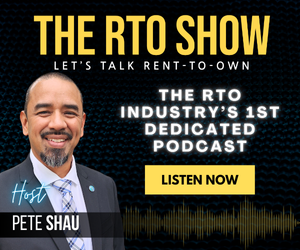The variety of products that can be put on an RTO agreement is vast, but recent litigation indicates it isn’t infinite. Here’s some help to learn your limits.
Common rent-to-own lore has it that RTO’s early, modest beginnings were rooted in Kansas in the 1960s, when the Talley brothers, Ernie and Willie, started renting TVs – just TVs – out of their Wichita store, Mr. T’s. But factually, it was much, much earlier, in the 1920s, when door-to-door peddlers tried moving Singer sewing machines using shortform rent-to-own agreements, but that effort failed.
Returning to 1960s Wichita, where renting TVs proved successful, so much so that several Mr. T’s employees went off on their own to expand the RTO concept – including such notables as Tom Devlin, Bud Holladay, Chuck Sims and others. These entrepreneurs grew the rent-to-own concept geographically, and soon RTO stores began offering “white goods”– washers, dryers, and refrigerators, mostly. Then, during the late 1970s and early ‘80s, brief product spurts off in other directions failed to launch – wigs, for example. And Sims noted the industry overall really missed an opportunity by not jumping on the “10-4 good buddy” bandwagon and offering CB radios installed in cars and trucks as rent-to-own products.
The industry added furniture in fits and starts during the ‘80s. Furniture rental is a bit more complicated than renting TVs – sourcing; warehousing; building out case goods, bed frames, and the like; delivering and setting up; recovering and refurbishing merchandise. All aspects of furniture rental presented challenges, so very different from simply getting a TV in a box from a supplier and delivering it. RTO has ultimately resolved all of these challenges, and furniture is and has been a mainstay rent-to-own product category for decades.
The furniture category expands and contracts from time to time based upon consumer tastes and product availability, as the variety of furniture products in the marketplace is almost infinite. While the industry began renting with traditional groupings – living rooms, dining rooms, bedrooms, and the like – some rental dealers moved beyond these traditions with products like pool tables, gaming tables, artificial fireplaces, gun cabinets, and others with mixed success. Experimenting with different furniture categories continues today – for example, most recently, faux fur loungers and snuggle chairs.
The ‘80s also saw rental dealers offering various jewelry categories. While some rent-to-own customers actively sought gold chains and bracelets, some RTO industry leaders had qualms about renting wedding jewelry. Today, there are still jewelry counters in some stores, but jewelry rentals as a percentage of overall rentals remains minor.
In the 1990s and early 2000s, innovative rental dealers began exploring tire and wheel rentals, and lo and behold, it became an extremely successful adjunct to traditional product categories. Indeed, tire and wheel rentals are the fastest growing rent-to-own segment in some markets.
Other category expansions over the years have included portable buildings, above-ground swimming pools, grills (electric, gas, and charcoal), playscapes, scooters, e-bikes, gaming chairs, massage chairs, tools, purses, cell phones, and the list goes on. The variety of products that can been put on an RTO agreement seems almost limitless … but is it? Recent lawsuits against some rent-to-own companies suggest there is a line. If so, where is it? And where should it be?
Products vs. services
What distinguishes RTO from all other consumer transactions in the marketplace is that the consumer is never obligated to continue making payments, and can cancel the transaction and return the property at any time. So logic suggests that if an item cannot be returned in more or less the same condition as when it was initially rented out, fair wear-and-tear excepted, then it may not be appropriate to put it on a rent-toown agreement. Likewise, one cannot rent services as opposed to products; how, for instance, can a customer return a haircut, a massage, or a golf lesson?
If that line is more or less clear, it becomes a bit more complicated when a transaction involves a mix of products and services. As an example, the Consumer Financial Protection Bureau (CFPB) is currently in litigation on the issue of vehicle repairs. Some car repairs are heavy on the product, some are heavy on the service; and, while it may be theoretically possible to return a fan belt, it’s arguably impossible to return an oil change or a paint job. The courts will ultimately decide what can and cannot be put on an RTO agreement, but rental dealers should be mindful there are limits to what can be offered, and the cautious approach is to avoid renting anything with a heavy service component.
A deal, if challenged, could change the nature of the transaction from lease to sale, likely a financed sale. For example, if a customer “rented” a golf lesson or a series of golf lessons via a rent-toown transaction, and the transaction were challenged, the courts could determine the transaction was not a true lease, but actually a financed sale of the lessons over time, without the proper disclosures.
What do RTO statutes themselves say about what can be put on an RTO agreement? One state – Indiana – has enacted outright prohibitions for certain categories of products that can be offered via RTO: “(1) motor vehicles (as defined in IC 9-13-2-105(a)), including: (A) component parts (as defined in IC 9-13-2-34); (B) major component parts (as defined in IC 9-13-2-95); and (C) any other parts (as defined in IC 9-13-2-122) other than: (i) wheels; (ii) rims; and (iii) tires; necessary to operate a motor vehicle; (2) other titled property; or (3) live domestic animals (as defined in IC 34-30-30-1); are prohibited under this article.” (Several states have enacted prohibitions against renting-to-own or selling domestic animals on credit; these statutes are all outside the RTO statutes and beyond the scope of this article.)
The Indiana rent-to-own statute also lists categories that, while not prohibited altogether, are nonetheless excluded from RTO coverage: musical instruments, dwellings whether deemed real or personal property, and any property in which the lessor does not have complete and total ownership rights at the time the agreement is executed.
Categorically uncovered
Similarly, other states’ rent-to-own statutes list certain categories of products, but rather than prohibiting their rental altogether, merely provide that the listed product categories are not covered by the statutes. The RTO statutes provide – with minor state variations – that if a transaction complies with the provisions of the law, then it is a lease for all purposes, and is not and cannot be construed to be a credit, installment, or conditional sale, nor a secured transaction under Article 9 of the Uniform Commercial Code. Not being covered means those products will not have the safe harbor protections against recharacterization provided by those statutes.
The rent-to-own statutes generally omit the following types of transactions from coverage: leases for commercial, business, or agricultural purposes; leases to an organization; and leases to governmental agencies or their subdivisions. The statutes also exclude leases of personal property incidental to a real estate transaction with no purchase option; leases of safe deposit boxes; and leases of real estate. For the most part, this language is surplusage to the definition of an RTO agreement in the statutes, all of which define the transaction as an agreement for the lease or rental of personal property or merchandise to a consumer for personal, family, or household purposes.
Many states do not define the kinds of property that can be rented under the rent-to-own statute at all or simply provide that “property” under the statute is “personal property” and does not include real estate: Alabama, Arkansas, California, Colorado, Connecticut, Delaware, Florida, Illinois, Nebraska, New York, Oklahoma, Rhode Island, South Carolina, and Texas.
Among states that list categories of products excluded from coverage under the RTO statute, several states limit the exclusion to motor vehicles: Alaska, Hawaii, North Dakota, Ohio, South Dakota, and Utah. Other states exclude automobiles from coverage: D.C., Idaho, Maine, Maryland, Virginia, and Washington. There may be no legal distinction between motor vehicles and automobiles under these statutes, but there may be. Louisiana is quite specific about the kinds of vehicles not covered by its rentto- own statute: automobiles, vans, and trucks weighing less than one ton.
Other states add other categories to their motor-vehicle exclusion:
- Arizona – manufactured homes, factory-built buildings, and recreational vehicles;
- Iowa – manufactured housing or mobile homes;
- Massachusetts – tools or garden equipment, leases of any property for less than seven days;
- Michigan – money or intangible personal property;
- Pennsylvania – money or intangible personal property, motor homes, mobile homes, manufactured housing;
- Vermont – mobile homes, assistive devices, musical instruments; and
- West Virginia – musical instruments, medical equipment, twoway communication equipment, leases with a financial institution as a party.
For the past few years, regulators have been taking a harder look at RTO transactions. As much as possible, rental dealers want to make their transactions bulletproof against any kinds of inquiries, challenges, or investigations. Overall, dealers are already paying close attention to the contractual, advertising, and price-tag disclosure requirements, as well as the price controls delineated in their state rent-to-own statutes on rental/lease fees and other charges. They must also watch closely what they are renting and ensure their products are bona fide rental products that can withstand whatever scrutiny may come their way.
Ed Winn III serves as APRO General Counsel.










